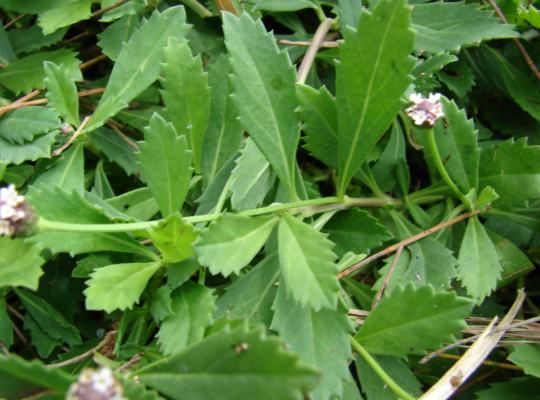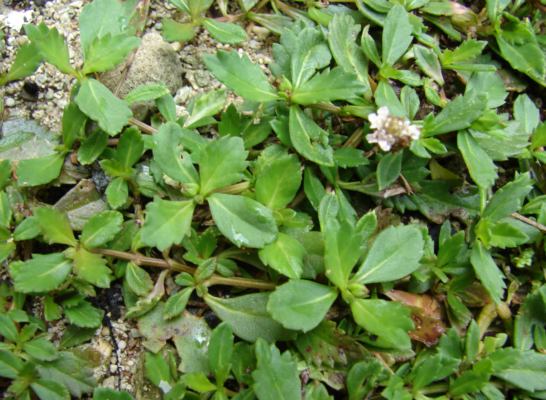Turkey Tangle-Unlocking the Herbal Wonders: Exploring the Medicinal and Therapeutic Potential
Tamil - Poduthalai Ilai keerai; Hindi Bhu Okra or Chota Okra

Table of Contents
About Turkey Tangle
Turkey Tangle Frog Fruit, scientifically known as Phyla nodiflora, is a low-growing perennial herb plant that belongs to the Verbenaceae family. This plant is native to the Americas and is commonly found in various regions, including the southeastern United States, Mexico, the Caribbean, and parts of South America.
Here are some key characteristics of Turkey Tangle Frog Fruit
Habitat: This plant is often found in a variety of habitats, including open fields, meadows, and disturbed areas. It can thrive in both moist and dry conditions.
Appearance: Turkey Tangle Frog Fruit is a low-growing plant with creeping stems that can form dense mats. The leaves are small, opposite, and oblong to lance-shaped, with a toothed margin. The foliage is often green, but the color can vary.
Flowers: The plant produces small, tubular flowers that are typically white or pale lavender. These flowers are clustered in the leaf axils and bloom throughout the growing season.
Fruit: The fruit is a small, rounded capsule containing tiny seeds. The plant is known as “Turkey Tangle Frog Fruit” due to the tangled appearance of its stems and the small fruits resembling turkey droppings.
Ecological Role: Turkey Tangle Frog Fruit is considered beneficial for wildlife, as it provides nectar for pollinators such as bees and butterflies. Additionally, the plant serves as a host for the larvae of certain butterfly species.
Landscaping: Because of its low maintenance and ability to form ground cover, Turkey Tangle Frog Fruit is sometimes used in landscaping and gardening, especially in areas with poor soil or difficult growing conditions.
Cultural Uses: In some traditional medicine practices, the plant has been used for various purposes, including the treatment of skin conditions.
It’s important to note that while Turkey Tangle Frog Fruit is generally non-invasive and can be beneficial in certain settings, its aggressive growth can sometimes make it challenging to control in cultivated areas where it is not wanted.
Origin
The Turkey Tangle Frog Fruit (Phyla nodiflora) is native to the Americas. Its natural range includes various regions such as the southeastern United States, Mexico, the Caribbean, and parts of South America. As a native plant, it has adapted to and evolved in these specific geographical areas over time. The plant’s introduction into different regions outside its native range might be a result of natural dispersal mechanisms or human activities.
What should you know about the leaf
While Phyla nodiflora (Turkey Tangle Frog Fruit) is not commonly known as a culinary plant, there are some mentions of its leaves being used in traditional medicine or consumed in certain cultures. However, it’s important to note that information on the edibility of this plant may vary, and caution should be exercised.
Before consuming any wild plant, especially for culinary purposes, it’s crucial to verify its edibility from reliable sources. Some plants may have toxic look-alikes or may cause adverse reactions in certain individuals. If there isn’t well-established and reliable information on the culinary use of Turkey Tangle Frog Fruit, it’s recommended to avoid consuming it until more information is available.
If you’re interested in using plants for culinary or medicinal purposes, it’s always a good idea to consult with experts or local resources who have knowledge about the specific plants in your region.
Phyla nodiflora, commonly known as Frog Fruit, is a perennial herbaceous plant with a rich history of traditional medicinal uses. Originating from India, this plant is recognized for its distinctive soft stems and leaves. The botanical name, Phyla nodiflora, highlights its taxonomic classification within the plant kingdom.
In addition to its culinary applications, Frog Fruit has found a place in traditional medicine, particularly in pediatric care. The soft stems and leaves of the plant are processed through frying and medicating, making it a key component in formulations aimed at addressing children’s indigestion issues.
Beyond its application in pediatric medicine, Frog Fruit has been historically employed in the treatment of various health conditions. The plant is known for its potential therapeutic effects on ulcers, tumors, joint pains, constipation, inflammation, bleeding disorders, gonorrhea, and swollen cervical glands. The diverse range of medicinal uses underscores the plant’s significance in traditional healing practices.
It’s important to note that while Frog Fruit has a long history of traditional use, it’s advisable to consult with healthcare professionals before using any herbal remedies, especially for serious medical conditions. Additionally, scientific research and clinical studies are ongoing to better understand the potential pharmacological properties of plants like Phyla nodiflora.

Nutrients
While specific nutrient content can vary among plants and depend on factors like soil quality, climate, and cultivation methods, I can provide a general overview of the types of nutrients commonly found in plants like Phyla nodiflora:
Vitamins: Plants often contain various vitamins, such as vitamin C, vitamin A (in the form of carotenoids), and various B vitamins. These vitamins play essential roles in various physiological functions, including immune system support, vision, and energy metabolism.
Minerals: Plants absorb minerals from the soil, and their composition can include minerals like potassium, calcium, magnesium, phosphorus, and trace elements such as iron and zinc. These minerals are crucial for the proper functioning of various biological processes in the human body.
Phytochemicals: Many plants, including medicinal herbs like Frog Fruit, contain phytochemicals, which are bioactive compounds that may have antioxidant, anti-inflammatory, and other potential health benefits. Examples include flavonoids, tannins, and alkaloids.
Fiber: Plant-based foods are often rich in dietary fiber, which is essential for digestive health. Fiber helps regulate bowel movements, supports a healthy gut microbiome, and may contribute to cardiovascular health.
Proteins: While plants may not be as concentrated a source of proteins as animal products, they still contain essential amino acids. Incorporating a variety of plant-based foods into the diet can help ensure an adequate intake of proteins.
Carbohydrates: Plants are a primary source of carbohydrates, providing energy for the body. This includes complex carbohydrates like starches and simple carbohydrates like sugars.
It’s important to note that the specific nutrient profile of Frog Fruit and other plants can vary, and the information provided here is a general overview. For precise information on the nutrient content of Phyla nodiflora, you may refer to scientific studies, and nutritional databases, or consult with experts in botany and plant chemistry.
Health Benefits
The traditional use of India Frog Fruit (Phyla nodiflora) in various medicinal applications suggests a range of potential health benefits. It’s important to note that while these benefits have been observed in traditional practices, scientific research is ongoing to validate and understand the mechanisms behind these effects. Here are potential health benefits associated with the medicinal use of India Frog Fruit:
Digestive Health: The soft stems and leaves of Frog Fruit are well-fried and utilized in pediatric medicine to address children’s indigestion. The plant may have properties that help soothe the digestive system and alleviate discomfort associated with indigestion.
Anti-inflammatory Properties: Frog Fruit has been traditionally used to treat inflammation. This suggests potential anti-inflammatory properties that may be beneficial in managing conditions related to excessive inflammation in the body.
Ulcer Treatment: Traditional uses include the treatment of ulcers. The plant may have properties that contribute to the healing of ulcers, possibly through its anti-inflammatory or protective effects on the gastrointestinal lining.
Anti-tumor Effects: The traditional use of Frog Fruit in treating tumors suggests potential anti-tumor properties. Phytochemicals present in the plant may possess properties that affect tumor growth, though further research is needed to understand the specific mechanisms involved.
Pain Relief (Joint Pains): Frog Fruit has been used traditionally for treating joint pains. It may have analgesic properties that help alleviate pain and discomfort associated with joint conditions.
Constipation Relief: The plant has been employed traditionally to address constipation. Its potential laxative properties may contribute to relieving constipation and promoting regular bowel movements.
Hemostatic (Bleeding): Traditional uses include the treatment of bleeding disorders. Frog Fruit may have hemostatic properties that help control bleeding, potentially due to its impact on blood clotting.
Anti-gonorrheal Properties: The traditional use of Frog Fruit in treating gonorrhea suggests potential antimicrobial or anti-gonorrheal properties, though more research is needed to confirm and understand these effects.
Anti-swelling (Swollen Cervical Glands): Traditional applications include the treatment of swollen cervical glands, indicating potential anti-inflammatory or lymphatic system-modulating properties.
It’s crucial to approach the use of traditional remedies with caution and consult with healthcare professionals, especially for serious health conditions. While traditional knowledge provides valuable insights, scientific validation is necessary to establish the safety and efficacy of herbal treatments.
Link to a Tamil You Tube Video
Exploring the Culinary Delights of Turkey Tangle Frog Fruit: From a Tamil YouTube Video.
Discover the intriguing world of Turkey Tangle Frog Fruit as shared in a Tamil YouTube video. In a quaint village in Kolumzhapra, Kerala, an old woman promises a unique culinary experience with this herb. She transforms it into a delectable chutney or thovaial, offering a taste that pairs exceptionally well with bread. The peculiar yet delightful flavor creates a memorable fusion, especially when traditional wheat roti is not readily available.
Join us on a flavorful journey as we delve into the diverse applications of Turkey Tangle Frog Fruit, exploring both its cultural significance and gastronomic potential. However, a word of caution: while consuming this herb in moderation can enhance your culinary experience, excessive intake may not be advisable. Uncover the secrets of this herbal gem and savor the distinctive tastes it brings to the table.
